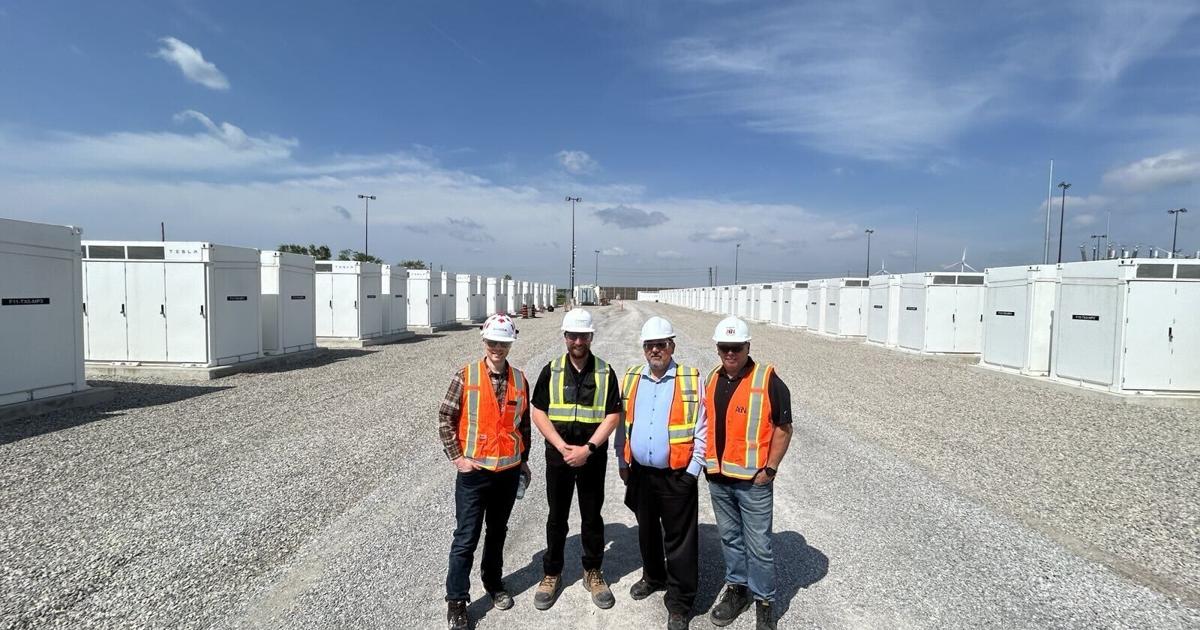NANTICOKE, Ont. — The strong winds that once blew toxic pollution from North America’s biggest coal plant over to the nearby Six Nations reserve now turn a forest of wind turbines owned by Indigenous People.
With the smoke stacks at Nanticoke long gone, row upon row of solar panels blanket the areas where mountainous piles of coal used to sit.
And as of April this year, Canada’s largest grid-scale battery project operates a stone’s throw away — planned, developed, constructed and owned with First Nations partners.
At a time when Indigenous groups across the country are up in arms over federal Bill C-5 and Ontario Bill 5, which they say bulldoze through their treaty rights to impose high priority development projects, Oneida Energy Storage shows, in the eyes of some, that another way is possible — one where Indigenous communities lead and development is delivered under budget and ahead of schedule.
“Conflict attracts attention. But progress like this is quiet,” said Matt Jamieson, president and CEO of Six Nations of the Grand River Development Corp.
Walking amid dozens of rows of colossal white batteries Friday, his words were both figurative and literal. Despite being able to provide 250 megawatts of electricity into the provincial grid — the equivalent of a mid-sized gas plant — the project is virtually silent.
And, unlike the natural gas peaker plants they can replace, the batteries produce no emissions.
“It fits within our mandate for environmental conservation, protection and stewardship,” said Warren Sault, president and CEO of Mississaugas of the Credit Business Corporation.
Premier Doug Ford was first elected in 2018 after campaigning against renewable energy, cancelling hundreds of projects and stopping all new investment dead in its tracks. But his government has since seemingly had a change of heart, signing contracts for nearly one gigawatt of wind power and soliciting proposals for more.
First Nations such as the Six Nations and the Mississaugas of the Credit River, which partnered on this project, have long been investors in renewable energy, and their experience put them ahead of the curve on recognizing that wind and solar power, because they don’t produce electricity around the clock, need to be paired with batteries to achieve their full potential.
The batteries charge up on excess power when it isn’t needed, like the middle of the night, and pump that electricity back into the grid when demand is high, like on a hot afternoon when people crank up the A/C.
“The hotter it gets, the more the grid needs the power — and it’s going to be a hot summer,” said Nick Zsofcsin, head of energy storage at Northland Power, which operates the project. “We don’t charge and discharge fully everyday, but the power is there when you need it.”
When Six Nations approached the province to pitch the battery project in 2017, they were met with skepticism, said Jamieson. But after some patient explanation and negotiation, Six Nations and their development partners at Northland and NRStor were able to strike a deal to have the province’s first large-scale battery project built, paving the way for an additional 2,800 megawatts of batteries the province contracted last year.
“It took a hell of a long time to convince the province to do this,” Jamieson said. “But once we did, they turned around and said, ‘We need a lot more of it.’”
Grid-scale batteries are being installed at a rapid pace around the world, with 11,000 megawatts installed globally in 2022, a 75 per cent increase over the previous year. With all the batteries in the pipeline, Ontario is set to become a leader, though it still trails California, which has the world’s most battery storage with more than 15,000 megawatts online.
The Oneida project has a 20-year contract, guaranteeing a long-term stable revenue stream for the nearby community on the Six Nations reserve. The Mississaugas of the Credit were brought in so they could benefit, as well.
The gleaming rows of batteries resemble an oversized outdoor change room, with little brass locks hanging off locker doors. Behind each door, there are 336 battery packs. With 24 lockers to a megapack and 278 megapacks on site, that’s more than 2.2 million batteries all together, each one individually monitored and isolated for safety.
The project has more storage capacity than 13,000 Tesla Model Ys, which is a good measure because the batteries themselves are manufactured by Tesla.
Strategically located to feed power into the high-voltage transmission lines that used to connect the Nanticoke coal plant to the grid, the batteries also power the nearby Imperial Oil refinery and the Stelco steel mill, two of the province’s largest users of electricity.
About 40 of the 180 construction jobs were filled by members of the Six Nations, who were able to take their expertise up the road as soon as they were done to start work on an even bigger battery project in Hagersville, which is slated to open before the end of the year.
At a time when legislation is being passed at the provincial and federal levels that assumes Indigenous people will be an impediment to development, Jamieson says the Oneida battery project shows how First Nations-led projects can be the key to achieving the goal of making Canada an energy superpower.
“I understand why government actors want to accelerate these large infrastructure projects, but they can’t simply do it at the expense of Indigenous voices,” he said. “Interestingly enough, we were the ones pushing them to move forward on this infrastructure project and now it’s become a key component of the energy market in Ontario.”



